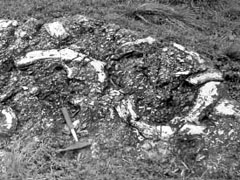
 |
de Steensplinter — Geology and a cosmology of the obvious | 9.1 mind |
 • Giant Rudist (bivalve mollusk) Titanosarcolites giganteus Trechman, found in Shaw Castle kindergarten schoolyard, Maldon inlier, Jamaica. Bivalve specimen; one valve broken into fragments. The shell originally lying on the shallow sea-floor, just as it is now lying on the ground. Living room surprisingly small. The length of the geological hammer is 33 centimeters. (author's photograph, 1967) previous (website version 2.30 - august 2007) |
mind The form-information retained in a record can, when observed, be transmitted by the optic nerve from the eyes of the scientist to his brain. This nerve can transmit the information but not the substance. The substance of the animal leaving tracks has gone. One of its footprints is an image, a record of form. The substance of the optic nerve does not participate in the contents of the message it transmits. Just as a message sent by wire is a record of form without substance, the substance of the wire not participating in the contents of the message. So also does the optical neural system serve to transmit the image, but its substance does not participate in it. The transmitted information can be further analyzed and interpreted by the brain. All mental processes in the brain are also processes of form, that leave further records of form, such as conclusions. Take the example of the Laetoli footprints of two hominids, walking together bare-foot over a newly-laid layer of volcanic ash. The one with the small feet walked in step with the other who had much larger feet, but both have the same step-length. My conclusion would be that this is a case of sexual dimorphism, a conclusion based on what I have learned about hominids, and on my observation of this picture. The form observation of this track is transmitted to my brain cortex. There is no neural substance involved in the mental message. The substance of axon and neural transmitters serves for the transmission, but it does not participate in the message. It is the brain where all those mental processes [named by Burgers] take place. It is a purely mental world consisting entirely of processes of form without substance. The neural substance serves for the transmission, but does not participate in the contents of the transmitted message. This is Burger's world of notions, "the notion of value, of purpose and of intention, of responsibility and of having a task". It is a personal world, but the thought categories discerned can be communicated and shared. Paleontologically speaking it is a young world, but its evolutionary development is not fully understood: • perception and transmission of the perceived to the brain has been an early development in the organic world • having a task is clearly experienced as such by parent birds feeding their young • and then their is the male bowerbird, that values blue colored decorations for its playground But at which point does consciousness begin to recognize these mental faculties - perception, value and having a task - as mental 'facts' sensu Burgers? Purpose came later and led to the possibility of mental interference. And in a later phase to the appearance of intent, permitting intended interference. At first such intent can be preverbal and even unconscious and pre-purpose. Perhaps this stage is already reached by mammal predators. Where and when it develops into purpose and purposeful interference I do not know. Such interfering processes may still be non-verbal as in the performance of music. Of course there are many other mental elements that do not result in interfering processes other than the brain itself, but they fall outside the scope of my cosmology. What all this amounts to is: • Only in processes involving living organisms with a brain sufficiently evolved to develop the element intent, can choice begin to make use of the available room for possibilities of intervention. • Only then can the word cause be introduced with any sense or meaning: intent denoting the final cause, making the intended happen the efficient cause. • Only then can we speak of responsibility. In short: This is why one should recognize the presence of form-elements (information) in material records; and why, because of their lack of substance, images of such form-elements can be transmitted mentally. Summarizing The information presented in a geological landscape has a certain identity of its own, independent of the substance. The geologist studying the area can observe this information, transmit what he sees by means of sensory perception, which is equipped for the transmission of the form observation but not of substance. In the brain, this form-information can be further processed into conclusions. continued |
| © 2007 - uitgeverij de Steensplinter - All rights reserved |